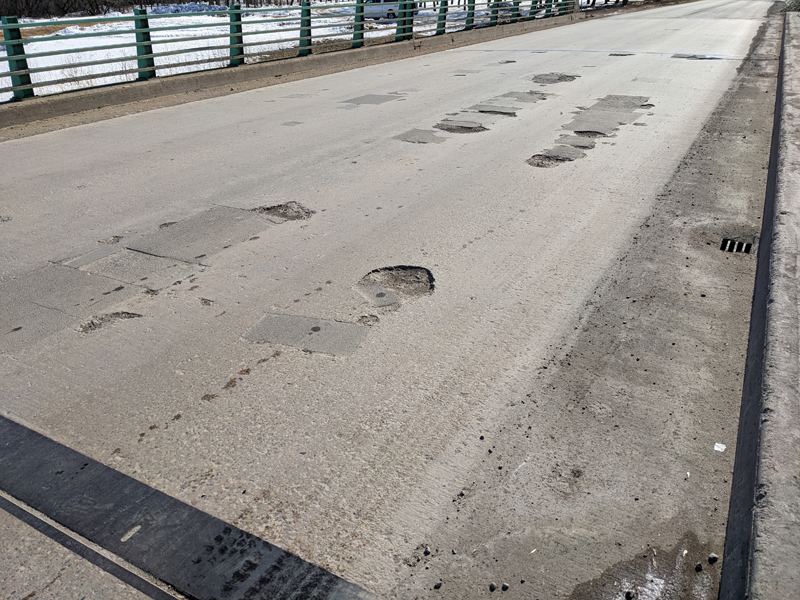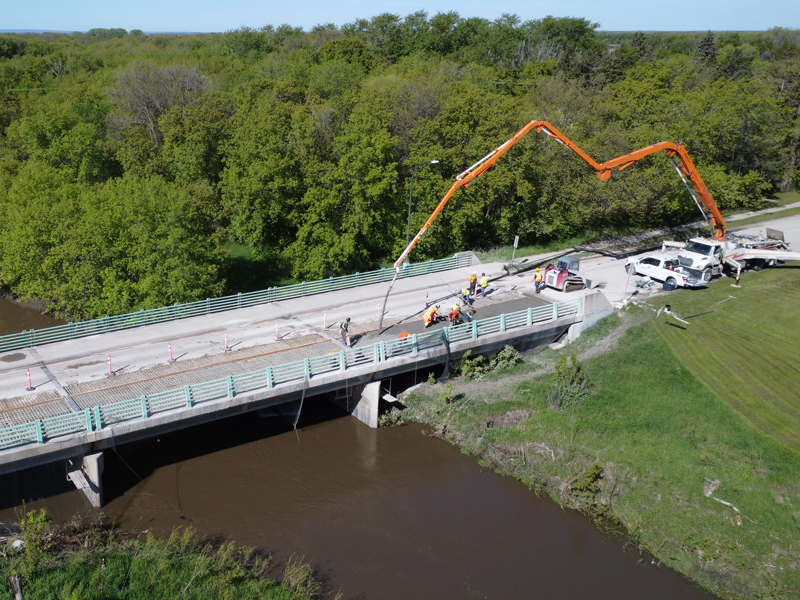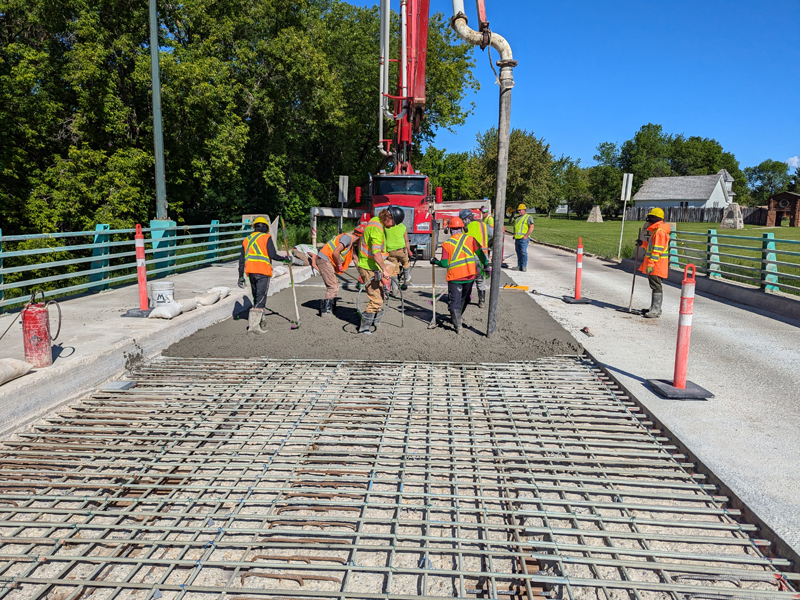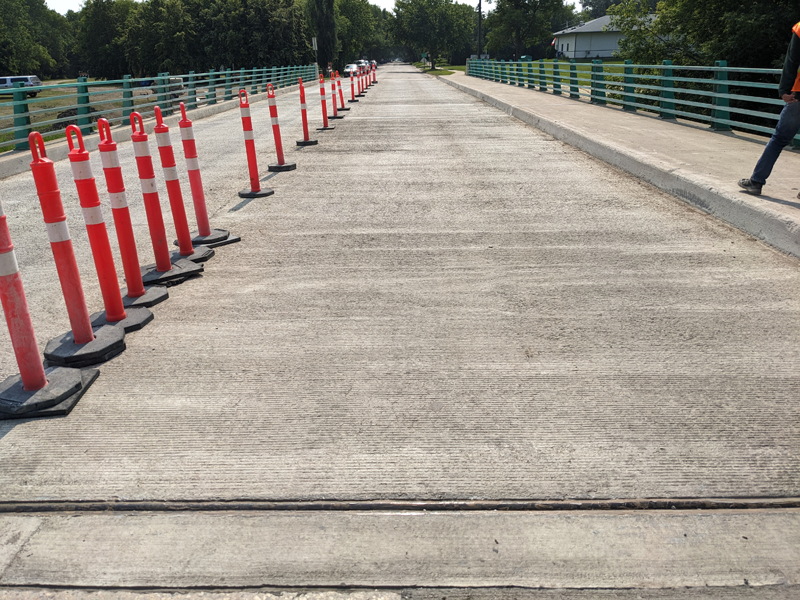Projects
Buckwold Bridge Rehabilitation – Dauphin, MB
Dillon was retained by the City of Dauphin to complete the detailed design and contract administration for the Buckwold Bridge Rehabilitation project. The City of Dauphin identified that completing repairs to the Buckwold Bridge, which crosses the Vermillion River on 4th Avenue SW within the City, should be a critical infrastructure project to address deterioration of the bridge deck and other bridge components.
The bridge was constructed in 1973 and had undergone minimal maintenance until a detailed inspection in 2020 highlighted the need for both short-term and long-term rehabilitation measures. The primary needs of the City included ensuring the structural integrity and safety of the bridge, improving the ride quality for vehicular traffic, extending its service life, and minimizing future maintenance costs. Additionally, the City wanted to support local and regional traffic and economic activities with a redundant and robust road network. Dillon was engaged to provide comprehensive engineering services, including preliminary design, detailed design, contract administration, and post-construction support, to meet these needs and deliver a sustainable and cost-effective rehabilitation solution.
In the City of Dauphin, 4th Avenue SW is one of only two streets that cross the Vermillion River along the western edge of the City, with Provincial Trunk Highway (PTH) 5A being the other. The Buckwold Bridge over the Vermillion River provides connectivity for local residents in the southwest and western areas of the City, and provides a lower volume crossing into and out of the City parallel to PTH 5A. Highlighting the importance of this road network link, the bridge is located in close proximity to the Dauphin Regional Health Centre, the Emergency Medical Services (EMS) ambulance depot, the Fort Dauphin Museum, and the City Public Works shop, in addition to the multiple residential neighbourhoods nearby. The Vermillion River originates at the Vermillion Reservoir, located at the base of Riding Mountain National Park, and conveys water run-off from the parkland, most significantly in the spring during snow-melt in the mountain area.
Dillon assembled a skilled, multi-disciplinary team to complete the project, which included preliminary design, life cycle analysis, detailed design, tender preparation, resident inspection, and contract administration during construction.
Preliminary Design
The primary objective of the preliminary design phase was to confirm the preferred approach for proceeding with the detailed design. To confirm the preferred approach, Dillon completed an end of service life analysis, prepared rehabilitation options, completed a life-cycle cost analysis (LCCA), and utilized a weighted criteria analysis to determine the preferred alternative. Dillon prepared five maintenance and rehabilitation options and compared them using a LCCA over a 50 year period, and also utilized a weighted criteria analysis using price-per-point methodology.
Detailed Design
The primary objectives of the detailed design phase were to complete a rehabilitation design that was safe, effective, and appropriately economical for the City of Dauphin. Dillon’s structural engineering team had already confirmed the need for a partial depth removal of the existing concrete deck and top layer of reinforcing during preliminary design. The thin geometry of the bridge deck would require a complex and costly design for a traditional rehabilitation to meet current code requirements, so Dillon proposed an innovative approach utilizing Glass Fiber Reinforced Polymer (GFRP) as the top layer of reinforcing. This allowed the design team to complete an economical hybrid reinforcing design that met current code requirements and minimized impacts to other bridge components.
Environmental Considerations
During the initial site visit, Dillon observed significant erosion in the southwest embankment near the south abutment. Dillon recommended that slope stabilization be included in the rehabilitation project to reduce the risk of structural instability of the abutment due to undermining caused by high water flood events. Dillon completed a hydrotechnical analysis to analyze the waterway, embankment, and existing bridge substructures to design appropriate slope protection measures. Environmental approvals were submitted and the City of Dauphin received authorization to proceed with mitigation measures, which were critical in protecting water quality and maintaining the health of the aquatic ecosystem.
Tender Preparation
As a smaller municipality with limited resources, the City of Dauphin does not have any of their own construction standards or specifications. Dillon has significant experience with the standards and specifications of Manitoba Transportation and Infrastructure (MTI); therefore, the project utilized and modified MTI’s comprehensive standards that would be familiar to local contractors bidding on the project. This provided great value for money to the City of Dauphin in all phases of the project, from design through to the end of construction.
Construction & Contract Administration
The final phase of Dillon’s assignment was the provision of contract administration and resident services during the rehabilitation of Buckwold Bridge. Following execution of the tendering process, Dillon was responsible for submittal review, request for information (RFI) response, resolution of construction issues, monitoring of contractor activities, and ensuring conformance with the contract specifications.
Multi-Disciplinary Integration
The Buckwold Bridge Deck Rehabilitation project exemplified a successful integration of multiple engineering disciplines, including structural bridge engineering, environmental and regulatory, hydrotechnical, and transportation. The multi-disciplinary approach was crucial to address the complex project challenges in a cost-effective manner for the City of Dauphin.
Project Details
Project Partner: City of Dauphin
Business Unit: Transportation
Service Offering: Bridges/Culverts




